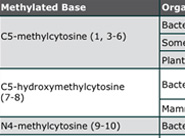
Methyltransferases for Epigenetics
Choose Type:
- How does Dnmt1 differ from SssI methylase?
- What should be considered if the methylation using SssI Methyltransferase is not going to completion?
- What should be considered if the methylation using Dnmt1 is not going to completion?
- What is the specific activity of SssI Methyltransferase?
- Can SssI methylated DNA be used to transform E. coli?
- Is S-adenosylmethionine (SAM) supplied with the Methyltransferase?
- Can Dnmt1 be heat inactivated?
- What source of tritiated SAM is recommended for use with Dnmt1?
- Does SssI Methyltransferase require magnesium in the buffer?
- What is the activity of SssI Methyltransferase in other NEBuffers, including rCutSmart?
- Will all the sites in the DNA become methylated by SssI Methyltransferase?
- What is the molecular weight of SssI (CpG) Methyltransferase?
- Can DNA be radiolabeled with SssI Methyltransferase?
- Can SssI Methyltransferase be used for generating a positive control for methylation-specific PCR or bisulfate sequencing?
- Can the SssI Methyltransferase methylate single stranded DNA?
-
Epigenetics - Expanding on Genomic Foundations
- Epigenetics Brochure
Feature Articles
Brochures
- Positive controls for methylation specific PCR or bisulfite sequencing
- CpG-methylated gene expression studies
- Nucleosome footprinting
| Amino Acid | Modification |
|---|---|
| Lysine | Methylation, Acetylation, Ubiquitination, Sumoylation, ADP-Ribosylation |
| Arginine | Methylation |
| Serine | Phosphorylation |
| Threonine | Phosphorylation |

References
- Kim, J.K., Samaranayake, M. and Pradhan S. (2009) Cell. Mol. Life Sci. 66, 596-612. PMID: 18985277
- Vanyushin, B.F. (2006) Curr. Top. Microbiol. Immunol. 301, 67-122. PMID: 16570846
- Mosher, R.A., Melnyk, C.W. (2010) Trends Plant Sci. 15, 204-210. PMID: 20129810
- Lyko, F., Beisel, C., Marhold, J., Paro, R. (2006) Curr. Top. Microbiol. Immunol. 310, 23-44. PMID: 16909905
- Selker, E.U., Freitag, M., Kothe, G.O., et al. (2002) Proc. Natl. Acad. Sci. U S A. 99, Suppl 4, 16485-16490. PMID: 12189210
- Kriaucionis, S. and Heintz, N. (2009) Science 324, 929-930. PMID: 19372393
- Tahiliani, M., Koh, K. P., Shen, Y., et al. (2009) Science 324, 930-935. PMID: 19372391
- Ehrlich, M., Wilson, G.G., Kuo, K.C., And Gehrke, C.W. (1987) J. Bacteriol. 169, 939-943. PMID: 3029036
- Svadbina, I.V., Zelinskaya, N.V., Kovalevskaya, N.P., Zheleznaya, L.A. and Matvienko, N.I. (2004) Biochem. (Moscow) 69, 299-305. PMID: 15061697
- Ratel, D., Ravanat, J-L., Berger, F. and Wion D. (2006) Bioessays 28, 309-315. PMID: 16479578
- Marinus, M.G. and Casadesus, J. (2009) FEMS Microbiol. Rev. 33, 488-503. PMID: 19175412
Products and content are covered by one or more patents, trademarks and/or copyrights owned or controlled by New England Biolabs, Inc (NEB). The use of trademark symbols does not necessarily indicate that the name is trademarked in the country where it is being read; it indicates where the content was originally developed. The use of this product may require the buyer to obtain additional third-party intellectual property rights for certain applications. For more information, please email busdev@neb.com.
This product is intended for research purposes only. This product is not intended to be used for therapeutic or diagnostic purposes in humans or animals.


